Zoom
Trash

MRK : Markos Kay. Markos R.
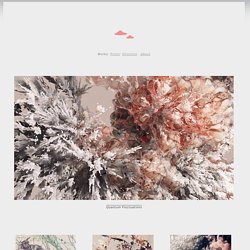
Kay is a digital artist, creative director, illustrator and lecturer with a focus in art & science. He is best known for his video art experiment aDiatomea (2007), exhibited at Ernst Haeckel's Phyletic Museum and the generative short film The Flow (2011) which even made it into a Breaking Bad episode. His art and design practice ranges from screen-based media, to projection and print. His work can be described as an ongoing abstraction and digitisation of the mysterious worlds of molecular biology and particle physics through a series of generative simulation experiments. These experiments explore the complexity and emergence of the invisible, and the computational paradigm of natural sciences. The History of Electronic Music in 476 Tracks (1937-2001)
Photo of Karlheinz Stockhausen by Kathinka Pasveer via Wikimedia Commons You may hear the phrase “electronic music” and think of superstar dubstep DJs in funny helmets at beachside celebrity parties.

Alternately, you may think of the mercurial compositions of Karlheinz Stockhausen, the musique concrete of Pierre Henry, or the otherworldly experimentalism of François Bayle. If you’re in that latter camp of music nerd, then this post may bring you very glad tidings indeed. Ubuweb---that stalwart repository of all things 20th-century avant-garde---now hosts an extraordinary compilation: the 476-song History of Electronic/Electroacoustic Music, originally a 62 CD set. Should art respond to science? On this evidence, the answer is simple: no way. Physics – it really does your head in.
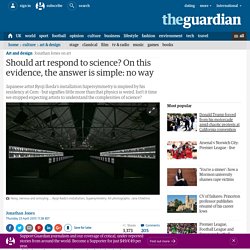
That seems to be the less than enlightening message the Japanese visual artist and composer Ryoji Ikeda – creator of the massive light beam Spectra that took over the sky in London last year to commemorate the first world war – took from a residency at Cern in Geneva. Ikeda’s installation Supersymmetry, staged in the darkened uppermost level of a multistorey car park, is apparently what you get when you introduce an artist to the world’s most advanced particle research insitute and its renowned Large Hadron Collider. A lot of sound and light, signifying nothing. Hackers build a new Tor client designed to beat the NSA. Anonymity’s toughest adversaries are hackers with the full-force and backing of Beijing, London, and Washington, D.C.

With the threat of powerful intelligence agencies, like the NSA, looming large, researchers have built a new Tor client called Astoria designed specifically to make eavesdropping harder for the world's richest, most aggressive, and most capable spies. Tor, the world’s most popular anonymity network, works like this: A user fires up the client and connects to the network through what's called an entry node. To reach a website anonymously, the user’s Internet traffic is then passed encrypted through a so-called middle relay and then an exit relay (and back again). That user-relay connection is called a circuit. The website on the receiving end doesn’t know who is visiting, only that a faceless Tor user has connected. Grow your own worlds [FoAM]
Quand l'angle d'or inspire un zéotrope imprimé en 3D, nos cerveaux fondent. Fibonacci Zoetrope Sculptures par Pier 9 sur Vimeo.
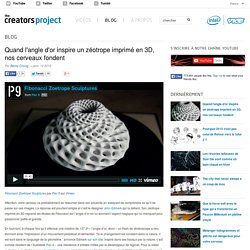
Attention, votre cerveau va probablement se retourner dans son enceinte en essayant de comprendre ce qu’il se passe sur ces images. La réponse est pourtant simple et c’est le designer John Edmark qui la détient. Son zéotrope imprimé en 3D reprend les études de Fibonacci sur l’angle d’or en lui donnant l’aspect magique qui lui manquait pour passionner petits et grands. Stephan Tual - Le Web sans les serveurs. «Artisans numériques», extrait «à lire en guettant le piratage généralisé» Artistes, activistes et théoriciens réunis au festival Accè)s( ont contribué à l’e-book «Artisans numériques», qui vient d’être mis en ligne.
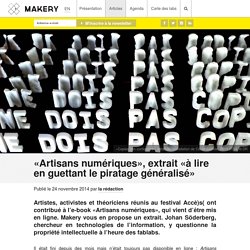
Makery vous en propose un extrait. Johan Söderberg, chercheur en technologies de l’information, y questionne la propriété intellectuelle à l’heure des fablabs. Il était fini depuis des mois mais n’était toujours pas disponible en ligne : Artisans numériques, l’e-book qui accompagnait l’édition 2012 du festival Accè(s) à Pau, sous la direction d’Ewen Chardronnet (par ailleurs contributeur de Makery) est à télécharger fissa sur le site des éditions HYX ! Le 18 octobre 2012, Accè(s) avait convié un tas de beau monde pour une journée autour des « enjeux technologiques, artistiques et sociétaux des fablabs ». Côté vulgarisation, le texte de Camille Bosqué (elle aussi contributrice pour Makery !)
Un texte de Johan Söderberg. Brusspup. An Artist Visualizes The Terrifying, Dystopian Metropolises Of Tomorrow. Arts numériques. Repairing a Computer Keyboard : Reassemble the Keyboard Assembly. Return the keyboard to the solid surface and carefully place the flexible caps at every key position.
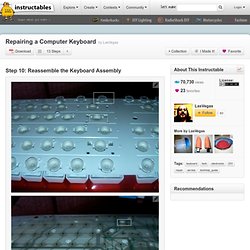
Note that some keys on the edges are pushed up by the weight of the assembly. Make sure that the little nub on the cap is in the key's hole. On the others the caps simply need to fit the recess. Ninety Six.